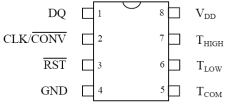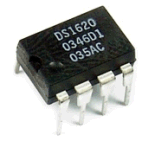

ultimo aggiornamento il 10 novembre 2008
|
 |
|
|
|
||
ultimo aggiornamento il 10 novembre 2008 |
| Quella visibile
nelle figura a fianco è un piccolo modulo (la basetta misura 24x20mm) con le funzioni di sensore di
temperatura ed è basato sull'integrato
DS1620 prodotto dalla MAXIM. Le sue caratteristiche sono
La scheda utilizza 3 linee del processore,
più alimentazione.
|
|
|
Questo modulo è descritto sul numero 277-278 in edicola nel mese di Luglio 2008 della rivista Fare Elettronica nella sezione ROBOT ZONE nell'articolo dal titolo Moduli input/output per la scheda robotica che descrive la costruzione di ben 11 moduli da collegare alla scheda basata sul processore BS2 SX di PARALLAX.
|
|
Schema a blocchi dell'integrato |
|
||||||||||||
|---|---|---|---|---|---|---|---|---|---|---|---|---|
Circuito stampato e disposizione componenti
|
|---|
| DS1620 Termometro e termostato digitale | ||
 |
|
 |
| Piedinatura | Datasheet | Foto dell'integrato |
| Montaggio e collaudo Per la costruzione del modulo si procederà iniziando dalla realizzazione del circuito stampato. Per la la sua realizzazione, si utilizzerà una basetta in vetronite (monofaccia) delle opportune dimensioni. Il metodo potrà essere quello della fotoincisione o del trasferimento termico utilizzando i cosiddetti fogli blu (PRESS-N-PELL) Una volta inciso il rame, si verificherà in controluce o mediante l’utilizzo di un multimetro che non vi siano cortocircuiti soprattutto tra le piste più vicine. Si passerà quindi alla foratura della stessa, utilizzando principalmente una punta da 0,8 mm o da 1 mm. In seguito, si potrà passare al posizionamento e alla saldatura dei componenti. Per la saldatura si utilizzerà un piccolo saldatore a punta fine, della potenza di circa 25 – 30 W. Si collegheranno il connettore SV1 con il connettore X4, della scheda BS2 SX mediante appositi cavi, aiutandosi con lo schema. Si passerà quindi al test del modulo, che non necessita di taratura. Utilizzando l’apposito programma, verrà visualizzato il valore della temperatura in gradi Celsius e Fahrenheit |
|
Lettura della temperatura tramite la finestra DEBUG
|
|
|---|
|
Lettura della temperatura tramite LCD seriale
|
|---|
| Elenco revisioni: | |
| 10/11/2008 | Inserito listato programma per gestione LCD seriale |
| 07/07/2008 | Inserito listato programma, altre immagini |
| 10/06/2008 | Aggiornato pagina. |
| 28/04/2008 | Emissione preliminare |